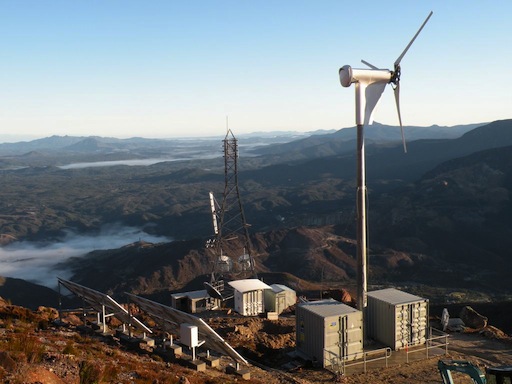Broadcast Australia has commissioned its first broadcast transmission site to be majority-powered by renewable energy, at Mount Owen near Queenstown in Tasmania. The location has been recently upgraded to use site-generated wind and solar power, which are together expected to reliably meet the site’s 8kW power needs for 80 – 90% of the time.
The windswept Mount Owen site broadcasts national and commercial analogue/digital radio and television services to the Queenstown and Zeehan area, plus supports critical radio communications for local emergency services.
Broadcast Australia’s Energy Systems Engineer Gary Café says the power demands of new services, such as digital television, were starting to exceed the capacity of the existing mains feed.
“As this is a remote facility, providing onsite renewable energy generation was a commercially viable option to enable the broadcast of digital television to the local area, compared with the cost of upgrading the mains feed. At 980m above sea level, Mount Owen benefits from a strong prevailing south-westerly wind, making it ideal for wind turbine power generation.
“Our requirement for a reliable mid-sized wind generator was something of a niche application, for which there isn’t a great deal of expertise in the marketplace, however, we have overcome the many challenges to achieve an outcome that allows these new technologies to be evaluated with very little risk to the onsite services.”
A constant-output horizontal-axis wind turbine has been erected on a 15m-high mast. The turbine is rated for maximum power generation of 15kW for a windspeed of 12m/s (43km/h). The wind turbine is supplemented by 36 square metres of mono-crystalline solar photovoltaic panels, rated at 5kW peak generating capacity.
The site is designed to operate primarily from wind and solar power. Excess generated electricity charges two banks of batteries which supplement the power supply when the combination of wind- and solar-generated power drops below the site demand of 8kW. The batteries alone can provide power for two days.
During periods of limited wind or lack of solar-generation, the balance of the site load can additionally be met from mains power, or from an onsite 31kVA diesel generator. This is set up to start automatically, but can be activated remotely from the Network Operations Centre. Equipped with a 1000-litre fuel reserve, the generator can provide total site power for ten days.
The newly installed equipment will potentially save up to 60MWh of conventional power each year. The company will use the experience gained from this site to deliver “far-reaching implications for Broadcast Australia’s carbon footprint for the future, as renewable power options are considered for a multitude of additional sites.”

